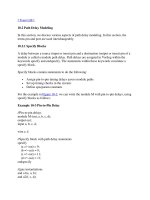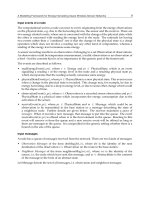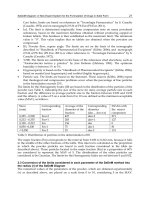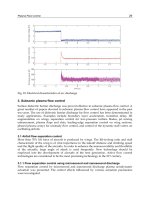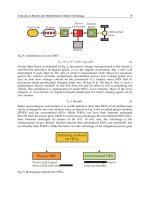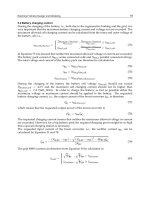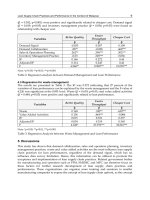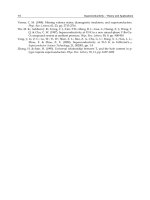Bees And Honey - Part 2 ppt
Bạn đang xem bản rút gọn của tài liệu. Xem và tải ngay bản đầy đủ của tài liệu tại đây (706.99 KB, 16 trang )
The bees behaviour
When the worker honeybee emerges from its cell, by biting around the
capping and squeezing itself through the hole, it is slightly lighter in
colour and more hairy than its older sisters. Young adults often take
quite a while to get out of their cells because the other workers take
little or no notice of them, and trample around on their heads quite
happily. But eventually they draw themselves out of the cells rather
like drawing a cork, and you might almost expect to hear a 'pop'. They
are a bit staggery on their feet and of course quite useless to the colony;
their glands are not working, they cannot sting, and the only work
possible for them to do is cleaning up, which is just the job they do for
the first three or four days. During this time they are being fed by the
other bees and their glands become activated and ready for use so that
by the end of the cleaning up periods their bodies are fully hardened
and in full working order; indeed they will usually take a short, few
minutes flight, not to forage for anything but just a trial flight around
the hive: what the beekeepers call a 'play flight'.
Now the bee is ready to do any job required by the colony and, as
observation has shown, it does a number of different jobs during the
course of each day. In the normal colony there is a very loose
progression through different jobs, according to age. This progression
is cleaning, feeding larvae, manipulating wax, processing honey, and
guard duty. However, any job can be done at any time and the needs of
the colony are paramount. This indoor work continues for about the
first twenty days of adult life, and during this time the beekeeper talks
of the bee as a 'house bee' or a 'nurse bee'. After this it becomes a
forager or 'flying bee' and its life style alters completely.
Behaviour of house bees
Many old grannies used to talk about the 'busy bee improving the
shining hour'. I am afraid they were a long way out as far as I can see:
the worker bee does not put in as many hours each day as most of us
humans. The other thing is that it sadly lacks concentration and the
ability to stick at a job for any length of time: observations have shown
that it rarely stays working at a job for more than half an hour. Its day
consists of resting, walking about and working in about equal
proportions, but these are not done in large blocks of time but for a few
minutes to half an hour at a time, and the three types of activity occur
randomly. An observation hive gives one a chance to see all types of
behaviour all the time. Resting bees often take up the most grotesque
attitudes, with legs stuck out at queer angles and bodies jammed into
corners, and one favourite place seems to be with their heads jammed
between the top of the high domed drone cells and the glass. The bees
which are on 'walk about' seem to do so with no particular aim but this
activity includes several very important pieces of behaviour. Probably
the most notable of these is the continual offering, and accepting, of
food between individuals. This goes on to such an extent that every bee
has very largely the same substances in its gut as every other bee. Not
only is food passed around at this time but also chemicals known as
'pheromones', some of which are obtained by licking the queen and
which control some of the behaviour patterns of the workers. As the
bees walk around they also look into cells and come into contact with
larvae that need feeding, ones which need to be sealed over, comb
building, repairs, and all the work of the hive. It is possible that this
continual recurring contact with the various needs of the colony will
cause them to do the work that is required—a direct stimulus-response
type of behavioural control. They also perform various dances which
as yet mean little to us but must contain specific messages. Two of
these dances are generally occurring at all times. One, where a worker
does a sort of jerky, jitterbug dance on the spot, may be a request for
grooming, as often another bee will dash over and start to nibble the
dancer, particularly between the thorax and abdomen. Perhaps this is
the bee equivalent of the spot between our shoulder blades: so difficult
to scratch. In the second dance a bee rushes about all over the place,
stopping occasionally to push its head against another bee, or to mount
slightly on to its back, vigorously vibrating its body up and down all
the while. It has been suggested that this has something to do with
swarming, but I think it is too general in occurrence for this, and
certainly does occur when there is no evidence of queen-cell
production, either current or imminent. These 'walk about' periods of
The queen surrounded by her retinue of workers, who are licking and grooming her.
She is being fed by the central bee at the top of the picture while two other workers lean over to
communicate with the queen, using their antennae. You can see the red tongue of the central
bee on the right licking the abdomen of the queen and obtaining queen substance. The worker
at top left shows the modified biting mouthparts, or mandibles, which are spoon-shaped in the
worker so that they can manipulate wax. Eggs can be seen in some of the lower cells and three
cells are sealed. The rather rough-edged cell between the two sealed cells at lower right is one
from which a worker has recently emerged, and which the cleaning bees have not yet tidied up.
control and cohesion of the colony as a whole.
The work periods are short and interspersed with walking and
resting, but with so many individuals work is progressing all the while,
day and night. An army of cleaners is licking everything clean and
polishing the inside and bases of the cells; damage to comb is being
repaired and if necessary torn down and rebuilt; larvae have their food
'piped' in around them, and pollen is eaten so that the glands can
manufacture bee milk. If I see larvae fully fed and ready for sealing in
an observation hive during the day, by the next morning this sealing
will have been done, and none will have been missed. The organization
is extremely good but we have only hazy ideas about the mechanisms
which trigger behaviour of this kind.
Every day there are batches of new adult workers emerging from
their cells, perhaps 1,000-2,000 of them as the colony gets to its full
size. These new workers find jobs in the centre of the brood nest and
start their working sequence. The effect of this must be to push our
original band of workers outside the brood area, where the work to be
done is processing the nectar to honey and, for those who move into the
area below the brood area, taking nectar from the foragers coming in
from the field. The honey processors add the enzyme invertase to the
nectar, and by manipulating it on the crook of the tongue (proboscis) so
that it forms a drop, increase the area of nectar in contact with the air
and thus the rate of evaporation. The drop is then sucked back into the
honey stomach and a new drop regurgitated for evaporation. This
evaporation is assisted by the hundreds of bees which are fanning the
air with their wings, thus replacing damp air in the hive by a flow of dry
air from outside. This is particularly noticeable in the evening, when a
good nectar flow is in progress; hives will be roaring with the sound of
fanning at dusk and the scent of the forage flowers will permeate the
whole area. Much of these volatile scent substances must be lost from
the nectar during processing to honey by the bee. The workers that
receive from the foragers their loads of nectar also observe the dance
the foragers do to communicate the position of the food they have been
working, and at the end of their time as house bees these workers are
directed to a particular flower and area of forage by this dance, which I
describe in detail later.
From about the fourth or fifth day after emergence, adult worker
bees go out on the play flights mentioned earlier. These tend to
increase in frequency somewhat and time spent flying gets longer as
Left A worker honeybee with a fair-sized load of willow pollen which she has collected, at
least in part, from the big catkin on which she is standing. The pussy willow, or palm, is of
great importance as a supplier of early pollen for brood rearing, and is well worth planting in
or near an apiary.
the bee gets older. Usually these flights occur in the afternoon, on a day
with reasonably good weather: warm, dry, and not too windy. The
young bees in an apiary often seem to go for play flights at roughly the
same time: it is quite startling when you first see the apiary a-buzz with
thousands of bees circling around. Many drones may be flying as well,
their deeper buzz making an unusual note in the apiary. The beginner
may feel a little intimidated at the number swirling around, but a few
moments observation should reassure him, as the individual bees are
taking no notice but fly round and round in circles of ever increasing
radius. The foragers will of course be flying through this throng in
their usual fairly straight lines, swinging down to the hive entrance and
scuttling indoors as rapidly as possible. At the same time the outward-
bound foragers are popping out of the entrance, often running up the
hive front and away, pausing sometimes to wipe their eyes and
antennae with the brushes on their front feet, and once airborne
vanishing rapidly into the distance.
The play-flight youngsters, however, cluster in the entrance with
quite a bit of grooming and mutual tapping of antennae. Once airborne
they fly backwards, facing the hive but gradually circling away until
finally they turn into their line of flight and circle around the hive,
gradually spiralling outwards. During this performance they are
learning to recognize the hive and the area in which it stands. It is as
though they have an automatic cine camera inside them somewhere
which photographs the hive, its surroundings and all the area they fly
over. This photograph is remembered and the bee is able to use it to
find its way back to the hive. It is quite interesting to test this out by
removing a large stone or some object from in front of and near to the
entrance to the hive. On arrival at the place where the picture has been
altered many bees will remain fussing around this area for some while
before going the last couple of feet to the hive. Some research workers
feel that this period of delay and then the final flight forward
demonstrates a basic deductive ability in the worker honeybee.
Whatever the process, however, the bee certainly learns the look of the
land for as far as it flies and hence the maxim, mentioned again later,
that if bees are to be moved it must be under 3 feet or over 3 miles.
Also, if for instance the grass is allowed to grow high in the apiary and
is then cut down, chaos will reign for some hours or even days. The
alteration of the picture over a large area will cause very considerable
'drifting', entry into the wrong hives, and the undoubted loss of some
of the older foragers who cannot adjust to a completely changed visual
environment.
Guard bees
This mention of drifting leads us on to another facet of behaviour:
guard duty and defence of the colony. In normal circumstances, when
all is quiet and nothing troubling the colony, there will be no guards at
the entrance. If, however, you tap on the hive a couple of times a bee
will appear in the entrance; a few more taps will produce many bees at
the entrance. Before long, if nothing can be seen of the cause of the
disturbance, one or more will take to the air and have a look around to
see what is going on. In other words, guards are only mounted when
there appears to be a need, and this can arise from any new occurrence,
like the tapping on the hive, by wasps or bees from other colonies
trying to steal the honey from the hive, or animals rubbing against the
hive, or even the vibration of a tractor or lawnmower nearby. I always
remember an incident when a tractor driver left his tractor running
opposite half a dozen colonies while he went to get something: we had
to go and win it back from the bees for him because he did not fancy
entering the milling crowd of bees that had surrounded it while he was
gone.
Once guards are mounted they will run across and challenge bees
entering the hive. What happens then depends upon the reaction of the
other bee to the challenge. A forager belonging to the colony will
completely ignore the guard and walk straight on into the hive, and the
guard will recognize it as a colony member by its smell. This 'colony
odour' is not an inherited scent (there is a slight genetic content) and
this is obviously likely to be the case when it is realized that the workers
of a colony are not all sisters but half-sisters in many cases, hence their
genetic origins are not entirely the same. The colony odour is a product
of the food eaten, and because of the very thorough food transfer all the
bees in a colony have the same substances in the same proportion in
their gut, and so their scent is the same. Different colonies will have
different odours because they will have a different mixture of the
various flowers of the district. Where colonies are on large areas of a
single flower this differentiation by colony odour breaks down, much
drifting occurs and often colonies become extremely irritable.
If a guard challenges another member of the colony, it recognizes its
'friendly' smell and does not press its challenge. However, a drifting
bee entering the colony by mistake, perhaps because it has been blown
down to the hive by a cross wind, or misled by a similarity of the
approach picture, will be challenged. In this case the guard will press
its challenge because the smell of this bee is not the right one. The
drifter, because its instinct says it is in the right place, will not try to
fight the guard but will submit. If the drifter is facing the guard it will
offer food, which the guard will usually ignore. If the guard is attacking
from the side, possibly hanging on to a wing or leg with its mandibles,
the drifter will tuck its tail in and stand quiet, with its head tucked
down, or it may rear on to its two back pairs of legs, extending its
tongue and strop this with its front legs. These patterns of behaviour
denote submission and the guard, although biting and pulling at its
wings and legs, and climbing all over it, will do no real harm and
certainly not attempt to sting. As with all bees, the guard's
concentration period is short, and in a few seconds it gets tired of the
whole affair and lets the drifter proceed, to be challenged several more
times by other guards. Of course, after it has been roughed up in this
The visiting bee in the centre of the melee is stropping her tongue in submission.
way several times the smell of the guards will rub off onto it and it will
become indistinguishable from others in the colony. This behaviour
pattern is used by the practical beekeeper when he unites two colonies
by the paper method (see page 163).
The position is quite different when the intruder is a robbing bee or
a wasp. In these cases the intruder fights back when challenged or tears
itself away and flies off. A fight may end with the death of one or both of
the combatants. In these fights the sting is used and once a successful
thrust has been made instant paralysis of the victim is certain. The
guards are alerted to robbing bees and wasps by their flight, which is a
characteristic-zig-zag flight across the entrance, trying to find a way in
without encountering the guards, readily observable by both the
guards and the beekeeper. This flight pattern alerts the colony and
prevents robbing from getting under way in many cases, and colonies
which do not mount guards or react to robbers quickly are soon wiped
out. Defence of the colony is necessary for its continued existence.
Foragers
We have now dealt with the life of the worker honeybee during the two
to three week period when it is a house bee. Let us now look at the
second half of its life. A bee's life in summer averages thirty to thirty-
five days from the time it emerges from the cell to its death, usually in
the field—it simply fails to make it home. Over-wintering bees, of
course, have a much longer life span, but they are much less active.
During the period when the bee is a forager it may be fetching into the
hive one of four things which are collected by the bees. These are
nectar, pollen, propolis and water. Nectar is sugar, water, and various
other ingredients in very small quantities, collected from flowers and
brought home in the honey stomach. Pollen, again collected from
flowers, provides the protein, vitamins and trace elements for the bee
diet. It is brought home as a load on the hind legs, as shown on page 34
and in the upper picture on page 52. Propolis is 'bee glue', used for
glueing down anything loose in the hive, filling holes too small for the
bees themselves to get through, and for varnishing and strengthening
comb. It is brought home from flower buds on the hind legs like pollen
but can be distinguished by its shiny appearance from the matt surface
of the pollen load. Water is needed to dilute honey so that it can be used
by the colony, and to cool the hive when temperatures are very high.
These substances will be carried by most bees at some time during
their lives and are usually carried one at a time, although some bees
carry combined loads of nectar and pollen. There is a suggestion,
however, that some bees are exclusively occupied in carrying propolis
throughout their foraging lives.
All of these substances except nectar are collected to satisfy the
colony's needs of the moment. Water is not stored at all, nor is there
Mouth to mouth food transfer. The worker on the left takes food from the one on the right.
any reserve of propolis. Pollen is stored, but not in vast quantities, and
even where 'pollen clogged combs' are a worry to beekeepers much
more pollen could be brought in and stored if the colony wished to do
so. The collection of nectar is unlimited and colonies will go on
collecting it as long as it is available and there is room to store it.
About 2 per cent of the bees reaching foraging age become scouts,
which go out into the field and fly from flower to flower, of any species,
and work them for nectar. They do several flights of this sort, finally
selecting the flower that in their experience gives the highest sugar
concentration and is sufficiently abundant to yield a full load easily and
quickly. Once this flower has been chosen the scout bee becomes
attached to that particular species for the rest of its life. It goes back to
the colony and performs a dance indicating the position of the flowers
it has been working, and gives out a sample of the nectar it has brought
in. The remaining foragers will become attached to one or other of
these dances and will go out to forage from the place indicated by the
dance. If these young bees can find a load easily, they too will dance so
that more bees will be attracted to forage a rewarding crop. Should
there be sufficient bees on the flowers in a particular area to remove the
nectar and thus make collecting a load difficult dancing ceases and so
does recruitment to the crop.
Scouts and foragers coming back to the colony give their nectar to
house bees, and this comprises a second selection process with regard
to the value of the forage. If scouts or young foragers bring back, let us
say, apple nectar with 25 per cent sugar whilst others are bringing in
kale nectar at 40 per cent or dandelion at 50 per cent, it is obvious
which bees will unload more easily. The house bees will accept the
higher sugar concentrations more readily, and if there is enough of the
higher nectar available then bees offering the lower value food may
find it so difficult to get rid of their load that they will cease to collect it,
and move to a more rewarding forage plant. This selection process
means that the colony makes the best use of the forage within its
district. This same type of selection is also known to work when a
colony is fed sugar syrup, as the very high concentration of sugar
diverts the foragers from collecting nectar and causes them to collect
pollen instead. This behaviour has prompted the feeding of syrup in
orchards in order to increase the efficiency of bees as pollinators. A
remarkable change in this type of behaviour, for the good of the
colony, has been seen in bees in the tropics. When water is needed to
cool the hive by evaporation the bees accept the weakest solutions of
sugar, or pure water, in preference to the highest as they would do in
normal circumstances, and in some cases they have even been known
to dance to indicate a water source.
The bee food-dances are well known and are illustrated below.
When the forage to be indicated by the bee is up to 100 yards from the
hive the bee dances as in fig. 7a. This dance says in effect, 'there is
nectar or pollen [depending upon which the forager is collecting] close
by: go and look for it.' It gives no indication of direction or any definite
distance. The bee runs around on the vertical face of the comb, in the
dark normally, following the path shown. Bees will be attracted to the
dancer and will rush around after it trying to keep within antenna-
touch. The whole dance is about 3/4 inch across and will move its
fig. 7a A bee performs the round dance, indicating forage close by, followed by four workers
who will later leave to search for the food, b The wagtail dance indicates both the direction
and distance of the food.
The worker in the centre is doing a vigorous wagtail dance. She has an unusually large
audience following her movements and learning from them information on the food source.
The more rewarding the source, the greater the vigour of the dance.
position as it is repeated. The bees which have followed the dance
receive a sample of nectar, or will smell the pollen load on the dancing
bee's legs and rush out to see if they can find the source. This is the
dance which can initiate robbing in an apiary if honeycomb is left open
to bees, or if honey is spilled on the ground. Once bees find honey (and
in the latter part of the season it will only be a few moments before they
will) they return to their colony with the spoils and dance, and within
ten to fifteen minutes the whole area will be full of searching bees,
trying to enter other colonies, and sheds and houses within a distance
of 100 yards. The person who left the honey about will be far from
popular!
When the distance to the food becomes greater the dance changes to
the complete 'wagtail' dance at around 100 yards depending upon the
race of bee involved. The wagtail dance is illustrated in fig. 7b. The
dancing bee runs around the figure-of-eight and then across the centre
in a straight line, wagging its abdomen vigorously from side to side. If
the straight wagtail line points vertically up the comb it conveys the
message, 'fly towards the sun'. If the bee runs down a vertical line the
message is 'fly directly away from the sun'. By moving this straight
run around at various angles (fig. 8) to the vertical the bee can indicate
the same angles from the sun. On the vertical face of the comb in the
hive it is using the force of gravity as its datum, and is indicating a
direction in the field with the sun as its datum. The rate at which the
bee dances, the number of complete figures-of-eight covered in a unit
of time, the length of time spent on the straight wagtail run, and the
duration and frequency of a buzz produced during the straight wagtail
part of the run are all correlated to the distance to the food source being
indicated. The longer the time spent on the wagtail run and the fewer
the number of complete dances occurring in a unit of time, the further
away is the source being indicated. The dancing bee stops every few
seconds and hands out samples of nectar or allows followers to examine
pollen loads on its legs. The followers are therefore provided with the
direction to fly, the distance to the food, the type of food to seek, its
scent and, in the case of nectar, its taste and sugar concentration. As far
as we know, no information is given regarding the colour of the flower
to be worked. The modus operandi of the followers is therefore assumed
to be that they fly out in the direction indicated for the prescribed
distance and then search coloured 'blobs' for the right smell, etc. Once
they find the right flower they can then use its colour to reduce the time
taken in searching for sufficient other flowers to obtain a load. There is
evidence that the bee may continue, at least on one complete foraging
trip, to work the colour of the first flowers it contacts. In some cases the
bee can differentiate between shades which are quite difficult for us to
separate and is seen to choose between two varieties of the same flower,
working only one of them.
The dance described above is much more complex than this brief
resume indicates. The sun is moving all the while, but the bee makes
allowance for this movement, adjusting its dance to the lapse of time
between flying home and dancing. This shows it has a sense of the
passage of time, a sense which has also been demonstrated by training
bees to come to feeding stations at a particular time of day. The bee can
also see polarized light from the sun, which we cannot. This means
that the bee knows the position of the sun using the sky's pattern of
polarization, which shifts relative to the position of the sun. This
accounts for the bee's ability to obtain a directional angle for a sun
almost at the zenith in the tropics. It also explains its ability to fly using
sun compass in cloudy areas for only a little polarized light is enough to
give it the information it requires.
Once the bee has become attached to a particular dance and
subsequently to a particular patch of flowers of the same species, it
tends to work these for the rest of its life. This is a short time only,
about fifteen days, and so the flowers will often persist for this length of
time. If, however, its particular species of flower comes to an end in the
first few days of the bee's foraging, it will shift its allegiance to another
plant, but should this happen towards the end of its life, it probably
ceases to forage altogether.
In the field the bee works very economically, moving from one
flower to another very close by. For instance, in orchards where the
trees are planted in tight rows, with much bigger spaces between the
rows than between the trees within the row, bees tend to work up and
down the rows with very few crossing from one row to another. This is
an important point to remember when pollination is required. In
dense forage such as clover or crucifers grown for seed, or dense stands
of heather, bees tend to walk rather than fly from one group of flowers
to another. You may expect to see bees flying from one head of clover to
the next, but if you look you will find them clambering about the maze
of heads and leaves rather than in the air.
The queen and the drone
Although the queen will live for several years she lives a much simpler
life than a worker. Her behaviour patterns are few and simple as far as
we know, and she has not the wide abilities of the worker to deal with
the general environment. The queen has evolved to the point where
her only contact with the world outside the hive is during her mating
flight and when she swarms, at which time she is well attended by
workers. She has two main functions to perform in her life: mating and
laying eggs.
The queen mates on the wing during the first ten to twenty days of
her life. Once she has emerged from her queen cell she becomes mature
within a couple of days, but by the time she is three weeks to a month
old she is no longer capable of mating properly. During her mature
period the worker bees become more and more aggressive towards her
up to the time she mates. This behaviour has a possible value in driving
the queen out for her mating flight before she is too old to accomplish it
efficiently.
The drone's only function as far as we know is mating with the
young queen, and as the drone dies when it mates any seen around
have apparently served no purpose at all. However, I always feel they
have much more use to the colony than we appreciate, since colonies
which are denuded of drones never seem to handle normally, although
it is hard to explain where the difference lies. Drones fly out of the hive
when the weather is reasonably warm and fine, flying around at about
thirty to ninety feet above the ground, depending upon the weather
conditions. In some areas they form drone collections where they tend
to congregate together in varying-sized centres of fairly high density.
This seems to occur mainly in hilly and mountainous areas. In flatter
areas with less erratic skylines they seem to spread out into a complete
large low-density network over the whole area.
The queen on her mating flight flys up to the level of the drones for
the day. Once she reaches the drone 'layer' the males, who have
completely ignored her both within the hive and at other heights below
the 'drone zone', are attracted to her by the scent of one of the
substances (9 oxydecenoic acid) produced in her mandibular glands,
and they form a 'comet tail' behind the queen and chase her by sight
once they get within about three feet of her. The first drone to reach
her is stimulated by another scent of unknown composition produced
by the queen, which causes him to mate with her. At the time of mating
the drone genitalia enters the queen and literally explodes, separating
from the drone, which dies. The genitalia remain in the vaginal
opening of the queen, with the torn end projecting from the tip of the
queen's abdomen. This latter is what the beekeeper calls the 'mating
sign' and is often seen on young queens who have just returned from a
mating flight. The queen, however, does not mate with just one drone
but on average with about five to fifteen, on one, two or three separate
flights. The 'mating sign' appears to be no hindrance to the queen's
mating again almost immediately, and probably she can remove it with
her legs. She appears to go on mating until her spermatheca is filled
with sperms, as sperm counts are shown to be very similar in density
despite variations in size of queen and spermatheca.
Mating having been accomplished, the queen starts egg-laying
within a few days, and is from then on very carefully looked after by the
worker bees. Up to the time of her mating they took little notice of her
or were aggressive towards her, but now she produces a scent which
A drone being evicted
by two workers.
causes them to turn and face her if she is close, thus forming the ring of
workers usually found around the queen, and called her 'retinue' by
die beekeeper (see page 33). These are not the same workers for very
long, however, for as she moves around those she comes close to turn to
face her but those at her rear are left behind and move away to continue
with other jobs. While workers are in her retinue they lick her, clean
her, and feed her, mainly on bee milk. The licking is very important
because it is by doing this that they obtain various substances from the
queen which control some of their behaviour. These substances, called
pheromones, are described in more detail in the next chapter.
The queen lays her eggs in the bottom of the cells, a few a day in
early spring but rising to a peak at the height of summer when she may
lay 1,500 to over 3,000 in a day, depending upon the race and strain.
This often amounts to far more than her own weight in eggs per day,
and hence her need for large quantities of very easily-assimilated food.
The need is supplied by bee milk from the bees of her ever-changing
retinue, with some honey to provide the energy to keep her going.
Although the queen has this limited spectrum of behaviour—
mating and laying eggs of the right kind in the correct cells—she is still
by far the most important bee in the colony, both to the colony and to
the beekeeper. She is mother of every bee in the hive. The whole
inheritance of all members of her colony comes through her. This
means that the working quality, the temper and the characteristics of
the colony come from the queen. Change the queen and within a
couple of months you have a completely new colony with, perhaps,
quite a different temperament. Not only does the queen pass on her
inherited characteristics to the colony, but also the number and the
viability of her eggs will control the ultimate size to which her colony
can grow. If she was poorly fed or came from a larva which started life
as a worker and had been fed as a worker for a couple of days then she
will never be able to produce a really good colony. Not only the
inherited qualities of the queen but her own nurture and development
will affect the future quality of the colony she will produce and head.
The quality of the drones with which she mates will have considerable
effect upon the inherited characteristics of her future colony, but the
beekeeper finds this far more difficult to control. The control of mating
is not yet a feasible technique for the vast majority of beekeepers; the
practical difficulties are great and usually glossed over very rapidly by
those advocating rigorous breeding. Breeding is a problem for
specialists, who have not as yet made much advance in this area.
The importance of the queen to the colony and methods of obtaining
good queens to replace her in due course should be something which
exercises the minds of all beekeepers, particularly those who set out to
obtain their living from honey production. This is dealt with in detail
in Chapter 8.
